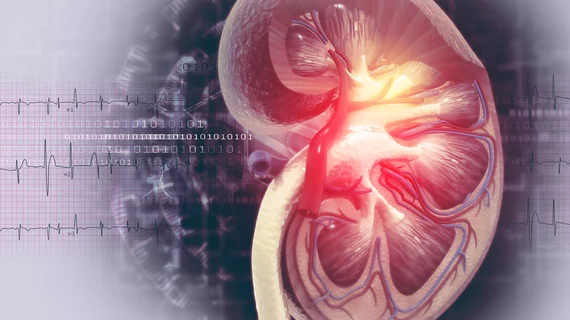Patients with end-stage renal disease (ESRD) face higher risks of in-hospital mortality and bleeding with transcatheter aortic valve replacement (TAVR) than patients who aren’t dialysis-dependent, researchers report in the Journal of the American College of Cardiology.
Co-first author Molly Szerlip, MD, of Baylor Scott and White Health in Plano, Texas, and colleagues studied more than 70,000 individuals in the Society of Thoracic Surgeons’ (STS) and American College of Cardiology’s (ACC) Transcatheter Valve Therapies (TVT) registry in an effort to determine how patients with both ESRD and severe aortic stenosis (AS) fare during TAVR. AS is the most common valvular lesion found in patients with ESRD, but traditional surgical aortic valve replacement (SAVR) results in 30-day mortality rates as high as 17.3%.
“Due to elevated proedural and 30-day mortality with SAVR, patients with ESRD are a population who may potentially benefit from TAVR, although the outcome of this procedure is unclear as ESRD patients were excluded from enrollment in pivotal clinical trials,” Szerlip and her team wrote in JACC. “There are a few series reporting acceptable results, but these series are very small and most larger studies show worse outcomes in TAVR patients with ESRD and chronic kidney disease (CKD).”
The researchers looked at data from the first 72,631 patients enrolled in the STS/ACC TVT registry, 4.2% of whom presented with ESRD at baseline. Compared with nondialysis patients, those with renal disease were younger (76 vs. 83 years old) and had higher rates of comorbidities, leading to a higher STS predicted mortality risk (13.5% vs. 6.2%).
As expected, Szerlip et al. found ESRD patients had higher in-hospital mortality rates, reaching a prevalence of 5.1% compared to nondialysis patients’ 3.4%. Though the observed to expected ratio was lower in individuals with ESRD—0.32 compared to 0.44 in non-ESRD patients—those with renal disease experienced higher rates of major bleeding (1.4% vs. 1% in nondialysis patients).
ESRD patients had a similar rate of major vascular complications as their counterparts (4.5% vs. 4.6%, respectively), but a higher overall one-year mortality rate (36.8% vs. 18.7%, respectively). They also tended to present with more diabetes, hypertension, peripheral vascular disease and worse heart failure symptoms.
“Szerlip et al. rightly note that the mortality risk of TAVR in ESRD patients increases with the number of comorbid conditions, while the need for alternative access to the femoral approach increases the risk of vascular access complications,” Rhode Island Hospital and Brown University’s George Bayliss, MD, wrote in a related editorial. “Thus, they suggest the need to carefully select patients. The message one may take from their work is that TAVR is a high-risk procedure for anyone with ESRD on dialysis or even approaching the need for dialysis.”
Bayliss said Szerlip and colleagues’ study is a start, but physicians will need more than this data to make adequate decisions about whether or not a dialysis patient should undergo TAVR. He wrote it will be critical to look into other factors, like alternatives to TAVR for the highest-risk ESRD patients and what separates successful TAVR procedures in CKD patients from unsuccessful ones.
“Although ESRD may not be an absolute contraindication to TAVR, just because we can replace the valve does not mean we should in every dialysis patient with severe AS,” Bayliss said. “More data is needed to identify a probably small subset of ESRD patients with AS who are too sick to undergo surgical repair, yet who would benefit from TAVR. Even then, those patients and their families need to know that the procedure carries high risk and may, at best, only buy a little more time.”

